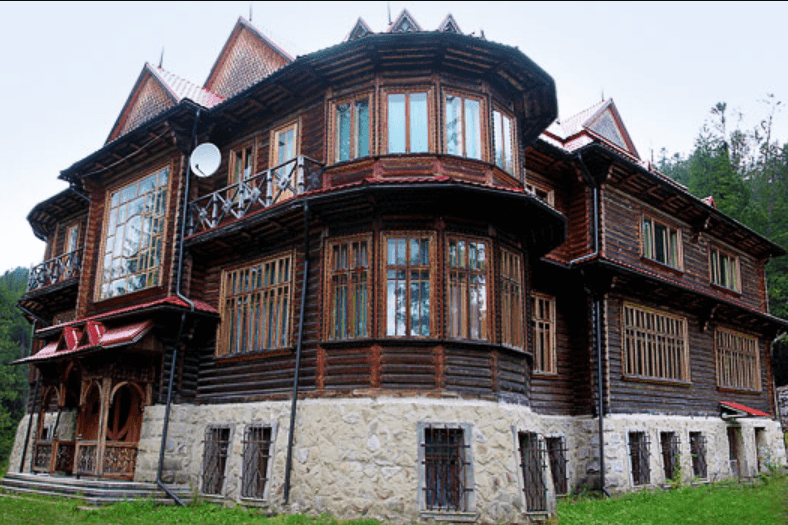The Kedrovi Palaty Recreation Complex is a former mansion of Metropolitan Andrey Sheptytskyi. In the picturesque Gorgany, surrounded by the mountains, outside the village of Osmoloda in Rozhniativ district, there is ravine Pidlyute, a place well-known not only in the Carpathian Foothills but all over Ukraine. The site people called Kedrovi Palaty is situated on the left bank of the Limnytsia, the purest river in Europe.
The prosperity of the ravine Pidlyute is closely connected with the history of the Greek Catholic Metropolis. It became known when Anhelovich served as a Metropolitan and in 1809 left Lviv running from Napoleon’s army to live in Anheliv in the Carpathians (several kilometers before Pidlyute) and intended to move to Hungary through the mountains. In the 1840s, when Metropolitan Cardinal M. Levytsky, the successor of Anhelovich, went for treatment in his own land and got rid of rheumatism in Pidlyute.
Lviv Bishop Sylvester Sembratovych, who, on the recommendations of specialists and doctors ordered to build a residence in Pidlyute for his summer holidays or for any guests, also paid attention to the healing air, forests rich in game, medicinal sulfur-iodine mineral springs. Then in an exotic corner of Boykivshchyna a log cabin-mansion The Kedrovi Palaty was constructed. However, during World War I it was destroyed by the Russian army under the command of General Brusylov.
Later Metropolitan Andrey Sheptytskyi renovated recreation and other buildings at his own expense. Then a narrowgauge railway to Pidlyute was laid. The choice of this particular ravine for the metropolitan residence is not accidental because there are three mineral springs in Pidlyute. Thus, there were three small pools named with the symbolic names Sylvester, Andrey and Tith. The elite from all over Austria-Hungary came here for the holidays and treatment. They tried to get rid of rheumatism, “female” diseases, diseases of the nervous system, bone tuberculosis and anemia. The chemical composition of the water in Pidlyte is similar to that in Truskavets, people drank it and used it for bathing. The residence became a famous resort where each summer people could get treatment. According to various data, their number reached from 120 to 350 people per year. Remarkable doctors worked in Pidlyte, treatment was available not only for the priesthood. Water from mineral hydrosulfuric springs was used to treat rheumatism and other diseases. In the late 1870s the residence was burned, and later rebuilt by masters of Kosiv.
In Pidlyute there were two houses for recreation for noble figures. Near the residence there were “vacation houses” (until 1939). There was a recreation pavilion with central heating built, which had thirty-one rooms for guests. As a way of entertainment people went to a shooter, a dancing, a bath and tennis courts. It was possible to go fishing and organize tourist walks to the surrounding mountains. Such trips were possible due to the construction of mountain paths – “raishtok” (“raishtok”– from German means “the way to ride a horse”). Guests could also use a ball room, a library or use a phone. For visitors there were organized trips to the Carpathian peaks such as Grofa, Ihrovets, Vysoka, Popadya or Syvulya, which is the highest peak in Gorgany in the part of the Ukrainian Carpathians between the rivers Svicha and Bystrytsya. Its height reaches 1836 meters.
Pidlyute was a favorite holiday destination for Andrey Sheptytskyi, who in his old age came to treat his legs that were injured by the cold in Russian captivity several times every summer. The Metropolitan himself, although sick, loved to travel the mountain paths on a special horse-drawn carriage. The elderly say that there used to be quite a rich museum with unique exhibits, but during World War II it was moved to Rozhnyatov, and eventually destroyed by the occupiers.
As for the building of the Kedrovi Palaty, old locals who were lucky enough to once visit the premises, remember that the room intended for Sheptytskyi was especially cozy and beautiful. The ceiling in it resembled the sky: on the east side there was the Sun drawn, on the west – there was the Moon, between them were some stars. Purple shades prevailed.
Opposite to the Kedrovi Palaty there was a grotto of stone with a massive stone cross on top (in the Soviet times militant atheists installed a sculpture of a deer instead). Metropolitan Andrey personally listened to confessions of the laity in this grotto, and he conducted the Liturgy in the local church.
In the Soviet period, Pidlyute appealed to not only the party authorities from Kyiv, but also those from Moscow. Khrushchev, Pidhornyi, Shelest, Shcherbytskyi came for the holidays there. It is rumored that even Galina Brezhneva went there with her friends. They got to the mountains on the narrowgauge railway Broshniv-Osmoloda which today is destroyed. Mostly, the purpose of their arrival was to hunt a bear. Petro Shelest was particularly zealous about it, it is said that animals were raised in cages so that he could shoot them right on the spot.
For a long time, the “Sheptytskyi’s holiday home” was taken care of by the local forestry plant, later the state forestry enterprise. In the 1970s, it belonged to the Chairman of the Supreme Council of the USSR M. Pidhornyi. At the same time, under mysterious circumstances, a fire broke out and the house was completely burned down. It was rebuilt only in the late 1980s. The residence is restored, the ancient grotto (late 19th century) is preserved. The former Kedrovi Palaty is still the central building, closely restored to its original appearance.
Now the whole complex is the Reccolection Center of the Ivano-Frankivsk Eparchy of the UGCC.


![Кедровіпалати[1]](https://woodenroute.ekarpaty.com/wp-content/uploads/2021/10/kedrovi20palaty1.png)